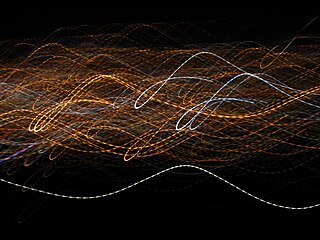In electrical engineering, the power factor of an AC power system is defined as the ratio of the real power absorbed by the load to the apparent power flowing in the circuit. Real power is the average of the instantaneous product of voltage and current and represents the capacity of the electricity for performing work. Apparent power is the product of root mean square (RMS) current and voltage. Due to energy stored in the load and returned to the source, or due to a non-linear load that distorts the wave shape of the current drawn from the source, the apparent power may be greater than the real power, so more current flows in the circuit than would be required to transfer real power alone. A power factor magnitude of less than one indicates the voltage and current are not in phase, reducing the average product of the two. A negative power factor occurs when the device generates real power, which then flows back towards the source.

In electricity generation, a generator is a device that converts motion-based power or fuel-based power into electric power for use in an external circuit. Sources of mechanical energy include steam turbines, gas turbines, water turbines, internal combustion engines, wind turbines and even hand cranks. The first electromagnetic generator, the Faraday disk, was invented in 1831 by British scientist Michael Faraday. Generators provide nearly all the power for electrical grids.

An alternator is an electrical generator that converts mechanical energy to electrical energy in the form of alternating current. For reasons of cost and simplicity, most alternators use a rotating magnetic field with a stationary armature. Occasionally, a linear alternator or a rotating armature with a stationary magnetic field is used. In principle, any AC electrical generator can be called an alternator, but usually the term refers to small rotating machines driven by automotive and other internal combustion engines.

An induction motor or asynchronous motor is an AC electric motor in which the electric current in the rotor that produces torque is obtained by electromagnetic induction from the magnetic field of the stator winding. An induction motor therefore needs no electrical connections to the rotor. An induction motor's rotor can be either wound type or squirrel-cage type.
A flexible alternating current transmission system (FACTS) is a system composed of static equipment used for the alternating current (AC) transmission of electrical energy. It is meant to enhance controllability and increase power transfer capability of the network. It is generally a power electronics-based system.
A static VAR compensator (SVC) is a set of electrical devices for providing fast-acting reactive power on high-voltage electricity transmission networks. SVCs are part of the flexible AC transmission system device family, regulating voltage, power factor, harmonics and stabilizing the system. A static VAR compensator has no significant moving parts. Prior to the invention of the SVC, power factor compensation was the preserve of large rotating machines such as synchronous condensers or switched capacitor banks.

A synchronous electric motor is an AC electric motor in which, at steady state, the rotation of the shaft is synchronized with the frequency of the supply current; the rotation period is exactly equal to an integer number of AC cycles. Synchronous motors use electromagnets as the stator of the motor which create a magnetic field that rotates in time with the oscillations of the current. The rotor with permanent magnets or electromagnets turns in step with the stator field at the same rate and as a result, provides the second synchronized rotating magnet field. A synchronous motor is termed doubly fed if it is supplied with independently excited multiphase AC electromagnets on both the rotor and stator.

In an electric circuit, instantaneous power is the time rate of flow of energy past a given point of the circuit. In alternating current circuits, energy storage elements such as inductors and capacitors may result in periodic reversals of the direction of energy flow. Its SI unit is the watt.

A load bank is a piece of electrical test equipment used to simulate an electrical load, to test an electric power source without connecting it to its normal operating load. During testing, adjustment, calibration, or verification procedures, a load bank is connected to the output of a power source, such as an electric generator, battery, servoamplifier or photovoltaic system, in place of its usual load. The load bank presents the source with electrical characteristics similar to its standard operating load, while dissipating the power output that would normally be consumed by it. The power is usually converted to heat by a heavy duty resistor or bank of resistive heating elements in the device, and the heat removed by a forced air or water cooling system. The device usually also includes instruments for metering, load control, and overload protection. Load banks can either be permanently installed at a facility to be connected to a power source when needed, or portable versions can be used for testing power sources such as standby generators and batteries. They are necessary adjuncts to replicate, prove, and verify the real-life demands on critical power systems. They are also used during operation of intermittent renewable power sources such as wind turbines to shed excess power that the electric power grid cannot absorb.
Doubly fed electric machines, also slip-ring generators, are electric motors or electric generators, where both the field magnet windings and armature windings are separately connected to equipment outside the machine.
An induction generator or asynchronous generator is a type of alternating current (AC) electrical generator that uses the principles of induction motors to produce electric power. Induction generators operate by mechanically turning their rotors faster than synchronous speed. A regular AC induction motor usually can be used as a generator, without any internal modifications. Because they can recover energy with relatively simple controls, induction generators are useful in applications such as mini hydro power plants, wind turbines, or in reducing high-pressure gas streams to lower pressure.

A static synchronous compensator (STATCOM), is a shunt-connected, reactive compensation device used on transmission networks. It uses power electronics to form a voltage-source converter that can act as either a source or sink of reactive AC power to an electricity network. It is a member of the FACTS family of devices.
In an alternating current (AC) electric power system, synchronization is the process of matching the frequency and phase and voltage of a generator or other source to an electrical grid in order to transfer power. If two unconnected segments of a grid are to be connected to each other, they cannot safely exchange AC power until they are synchronized.

An electric power system is a network of electrical components deployed to supply, transfer, and use electric power. An example of a power system is the electrical grid that provides power to homes and industries within an extended area. The electrical grid can be broadly divided into the generators that supply the power, the transmission system that carries the power from the generating centers to the load centers, and the distribution system that feeds the power to nearby homes and industries.
In electrical power engineering, fault ride through (FRT), sometimes under-voltage ride through (UVRT), or low voltage ride through (LVRT), is the capability of electric generators to stay connected in short periods of lower electric network voltage. It is needed at distribution level to prevent a short circuit at HV or EHV level from causing a widespread loss of generation. Similar requirements for critical loads such as computer systems and industrial processes are often handled through the use of an uninterruptible power supply (UPS) or capacitor bank to supply make-up power during these events.
A permanent magnet synchronous generator is a generator where the excitation field is provided by a permanent magnet instead of a coil. The term synchronous refers here to the fact that the rotor and magnetic field rotate with the same speed, because the magnetic field is generated through a shaft mounted permanent magnet mechanism and current is induced into the stationary armature.

Synchronverters or virtual synchronous generators are inverters which mimic synchronous generators (SG) to provide "synthetic inertia" for ancillary services in electric power systems. Inertia is a property of standard synchronous generators associated with the rotating physical mass of the system spinning at a frequency proportional to the electricity being generated. Inertia has implications towards grid stability as work is required to alter the kinetic energy of the spinning physical mass and therefore opposes changes in grid frequency. Inverter-based generation inherently lacks this property as the waveform is being created artificially via power electronics.

Capability curve of an electrical generator describes the limits of the active (MW) and reactive power (MVAr) that the generator can provide. The curve represents a boundary of all operating points in the MW/MVAr plane; it is typically drawn with the real power on the horizontal axis, and, for the synchronous generator, resembles a letter D in shape, thus another name for the same curve, D-curve. In some sources the axes are switched, and the curve gets a dome-shaped appearance.
Voltage control and reactive power management are two facets of an ancillary service that enables reliability of the transmission networks and facilitates the electricity market on these networks. Both aspects of this activity are intertwined, so within this article the term voltage control will be primarily used to designate this essentially single activity, as suggested by Kirby & Hirst (1997). Voltage control does not include reactive power injections within one AC cycle; these are a part of a separate ancillary service, so-called system stability service. The transmission of reactive power is limited by its nature, so the voltage control is provided through pieces of equipment distributed throughout the power grid, unlike the frequency control that is based on maintaining the overall active power balance in the system.
In an electrical grid, the short circuit ratio is the ratio of the short circuit apparent power (SCMVA) in the case of a line-line-line-ground (3LG) fault at the location in the grid where some generator is connected to the power rating of the generator itself (GMW). Since the power that can be delivered by the grid varies by location, frequently a location is indicated, for example, at the point of interconnection (POI):






























